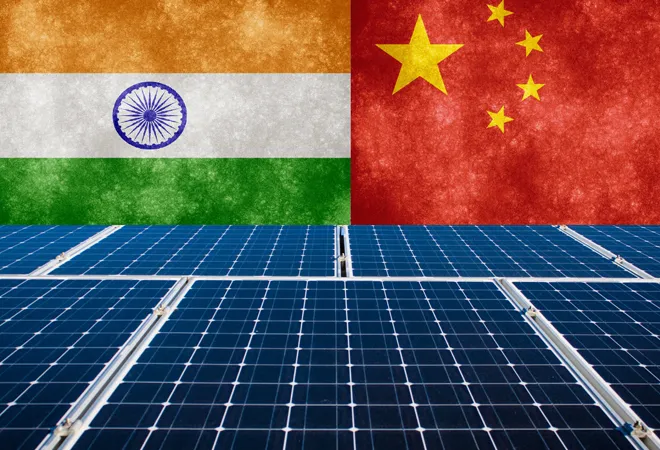It is a well-known fact that China’s solar sector is highly subsidised. This was the official reason for US President Donald Trump’s announcement of a 30% tariff on imported solar equipment in January as Chinese solar companies undercut US solar manufacturers. The Narendra Modi government is walking down the same path; it has imposed a safeguard duty (SGD) on solar cells and modules from China (and Malaysia), effective 30 July. About 85% of India’s solar cells come from both countries. The argument for such a trade intervention is the rising “dependency” on China on one hand and economic and employment loss on the other.
From an environmental, economic as well as (energy) security standpoint, such tariffs are unfortunately counterproductive. China has acquired tremendous experience in the production process, which gives its companies a worldwide lead in production efficiency. As a result, China can offer low prices due to economies of scale. And abundant supply means prices may drop by about 35% in 2018 and another 10-15% in 2019.
Compared to India, the US has significant solar production capacity. There, higher prices could be partly compensated by better quality. However, India’s current production of solar cells and modules is much less sophisticated and not competitive enough to replace the Chinese product. Catching up with China would require tremendous capital investment — with no promise of return as the decreasing prices further reduce profit margins. In short: India will not be able to generate significant profit from national solar cell production.
Germany’s solar industry has already experienced this conundrum. Once prosperous and driven by subsidies, it could not keep up with China’s low-cost production. In 2013, Robert Bosch GmbH, a leading supplier of technology and services, sold all solar cell related operations, losing around €4 billion. It has the same problem with another technology too: Today, nine out of 10 batteries are produced in China, South Korea or Japan. This year, Bosch decided to stall further investment in battery technologies as 20% of market share would have required an investment of €20 billion. The train left the station many years ago.
What about employment? Import tariffs will raise the general price levels for solar cells and solar photovoltaic power plants, the number of installations will drop and employment will be affected. Solar cell and module production is a highly automated process, which requires high-end precision machines rather than headcount. The real job potential is in installation and maintenance. It is this field which will be negatively affected. In the US, renewable energy companies cancelled investments of more than $2.5 billion in large installation projects shortly after Trump’s intervention. Thousands of jobs were lost.
Ultimately, the consumer will pay the premium. This is particularly true and an even more sensitive matter in India, where a significantly lower per capita income and limited capital are closely related to economic development and growth rates. Higher energy prices drive costs. Lower energy prices drive the economy. A growing economy increases energy demand — and prices if energy supply does not grow accordingly.
This is why an import tax on solar cells ironically undermines India’s own magic formula for the energy transition: an effective carbon emissions reduction along with economic development and electrification of the country. The ambitious target of 175GW renewable energy capacity by 2022 — now raised to 227GW — led to significant price drops in renewable energy installation prices. Today, electricity from renewables is offered for ₹2.4 per kilowatt-hour (kWh) while coal-based power is sold for less than ₹3.7 per kWh — far below its break-even of an estimated ₹5. It is no surprise that discoms prefer the cheaper energy while coal power plants are faced with load factors below 57%.
These historic low levels, however, are accompanied by rising coal imports — from 137 million tons in 2017 to an expected 145 million tons this year. This does not map with the often promised energy independence gained by national coal power. And as thermal power is freshwater-dependent, losses are increasing further, together with the number of droughts. More and more conventional power plants are turning into stranded assets and are being pushed out of the market. Coal, often declared as the perfect energy source for India, will further lose its significance. This is why the energy transition is inevitable and more a political than a technological challenge. Jobs will be lost on one side and will have to be created on the other.
Instead of a threat to India’s security and economy, China’s subsidised solar sector can be seen as a gift. China practically pays for India’s energy transition, which will help to end the dependency on fossil fuels and will reduce the effects on climate and public health in the long run. Given the chance to get the transition subsidised by another country, the Indian government’s introduction of the SGD seems irrational. It will increase solar power rates to around ₹3 per unit, diminish employment potential, reduce power supply, and drive up energy prices. In other words, this policy helps nobody — not even the coal industry. It is a market intervention which sounds more like Trump than Modi.
This article originally appeared on Live Mint.
The views expressed above belong to the author(s). ORF research and analyses now available on Telegram! Click here to access our curated content — blogs, longforms and interviews.




 PREV
PREV


